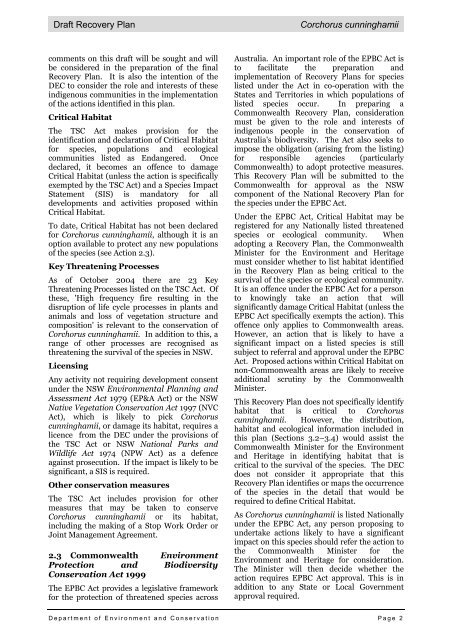Corchorus cunninghamii - Department of Environment and Climate ...
Corchorus cunninghamii - Department of Environment and Climate ...
Corchorus cunninghamii - Department of Environment and Climate ...
Create successful ePaper yourself
Turn your PDF publications into a flip-book with our unique Google optimized e-Paper software.
Draft Recovery Plan <strong>Corchorus</strong> <strong>cunninghamii</strong><br />
comments on this draft will be sought <strong>and</strong> will<br />
be considered in the preparation <strong>of</strong> the final<br />
Recovery Plan. It is also the intention <strong>of</strong> the<br />
DEC to consider the role <strong>and</strong> interests <strong>of</strong> these<br />
indigenous communities in the implementation<br />
<strong>of</strong> the actions identified in this plan.<br />
Critical Habitat<br />
The TSC Act makes provision for the<br />
identification <strong>and</strong> declaration <strong>of</strong> Critical Habitat<br />
for species, populations <strong>and</strong> ecological<br />
communities listed as Endangered. Once<br />
declared, it becomes an <strong>of</strong>fence to damage<br />
Critical Habitat (unless the action is specifically<br />
exempted by the TSC Act) <strong>and</strong> a Species Impact<br />
Statement (SIS) is m<strong>and</strong>atory for all<br />
developments <strong>and</strong> activities proposed within<br />
Critical Habitat.<br />
To date, Critical Habitat has not been declared<br />
for <strong>Corchorus</strong> <strong>cunninghamii</strong>, although it is an<br />
option available to protect any new populations<br />
<strong>of</strong> the species (see Action 2.3).<br />
Key Threatening Processes<br />
As <strong>of</strong> October 2004 there are 23 Key<br />
Threatening Processes listed on the TSC Act. Of<br />
these, 'High frequency fire resulting in the<br />
disruption <strong>of</strong> life cycle processes in plants <strong>and</strong><br />
animals <strong>and</strong> loss <strong>of</strong> vegetation structure <strong>and</strong><br />
composition' is relevant to the conservation <strong>of</strong><br />
<strong>Corchorus</strong> <strong>cunninghamii</strong>. In addition to this, a<br />
range <strong>of</strong> other processes are recognised as<br />
threatening the survival <strong>of</strong> the species in NSW.<br />
Licensing<br />
Any activity not requiring development consent<br />
under the NSW <strong>Environment</strong>al Planning <strong>and</strong><br />
Assessment Act 1979 (EP&A Act) or the NSW<br />
Native Vegetation Conservation Act 1997 (NVC<br />
Act), which is likely to pick <strong>Corchorus</strong><br />
<strong>cunninghamii</strong>, or damage its habitat, requires a<br />
licence from the DEC under the provisions <strong>of</strong><br />
the TSC Act or NSW National Parks <strong>and</strong><br />
Wildlife Act 1974 (NPW Act) as a defence<br />
against prosecution. If the impact is likely to be<br />
significant, a SIS is required.<br />
Other conservation measures<br />
The TSC Act includes provision for other<br />
measures that may be taken to conserve<br />
<strong>Corchorus</strong> <strong>cunninghamii</strong> or its habitat,<br />
including the making <strong>of</strong> a Stop Work Order or<br />
Joint Management Agreement.<br />
2.3 Commonwealth <strong>Environment</strong><br />
Protection <strong>and</strong> Biodiversity<br />
Conservation Act 1999<br />
The EPBC Act provides a legislative framework<br />
for the protection <strong>of</strong> threatened species across<br />
Australia. An important role <strong>of</strong> the EPBC Act is<br />
to facilitate the preparation <strong>and</strong><br />
implementation <strong>of</strong> Recovery Plans for species<br />
listed under the Act in co-operation with the<br />
States <strong>and</strong> Territories in which populations <strong>of</strong><br />
listed species occur. In preparing a<br />
Commonwealth Recovery Plan, consideration<br />
must be given to the role <strong>and</strong> interests <strong>of</strong><br />
indigenous people in the conservation <strong>of</strong><br />
Australia's biodiversity. The Act also seeks to<br />
impose the obligation (arising from the listing)<br />
for responsible agencies (particularly<br />
Commonwealth) to adopt protective measures.<br />
This Recovery Plan will be submitted to the<br />
Commonwealth for approval as the NSW<br />
component <strong>of</strong> the National Recovery Plan for<br />
the species under the EPBC Act.<br />
Under the EPBC Act, Critical Habitat may be<br />
registered for any Nationally listed threatened<br />
species or ecological community. When<br />
adopting a Recovery Plan, the Commonwealth<br />
Minister for the <strong>Environment</strong> <strong>and</strong> Heritage<br />
must consider whether to list habitat identified<br />
in the Recovery Plan as being critical to the<br />
survival <strong>of</strong> the species or ecological community.<br />
It is an <strong>of</strong>fence under the EPBC Act for a person<br />
to knowingly take an action that will<br />
significantly damage Critical Habitat (unless the<br />
EPBC Act specifically exempts the action). This<br />
<strong>of</strong>fence only applies to Commonwealth areas.<br />
However, an action that is likely to have a<br />
significant impact on a listed species is still<br />
subject to referral <strong>and</strong> approval under the EPBC<br />
Act. Proposed actions within Critical Habitat on<br />
non-Commonwealth areas are likely to receive<br />
additional scrutiny by the Commonwealth<br />
Minister.<br />
This Recovery Plan does not specifically identify<br />
habitat that is critical to <strong>Corchorus</strong><br />
<strong>cunninghamii</strong>. However, the distribution,<br />
habitat <strong>and</strong> ecological information included in<br />
this plan (Sections 3.2–3.4) would assist the<br />
Commonwealth Minister for the <strong>Environment</strong><br />
<strong>and</strong> Heritage in identifying habitat that is<br />
critical to the survival <strong>of</strong> the species. The DEC<br />
does not consider it appropriate that this<br />
Recovery Plan identifies or maps the occurrence<br />
<strong>of</strong> the species in the detail that would be<br />
required to define Critical Habitat.<br />
As <strong>Corchorus</strong> <strong>cunninghamii</strong> is listed Nationally<br />
under the EPBC Act, any person proposing to<br />
undertake actions likely to have a significant<br />
impact on this species should refer the action to<br />
the Commonwealth Minister for the<br />
<strong>Environment</strong> <strong>and</strong> Heritage for consideration.<br />
The Minister will then decide whether the<br />
action requires EPBC Act approval. This is in<br />
addition to any State or Local Government<br />
approval required.<br />
<strong>Department</strong> <strong>of</strong> <strong>Environment</strong> <strong>and</strong> Conservation Page 2

















